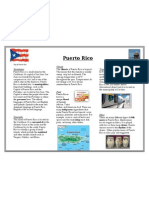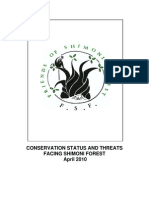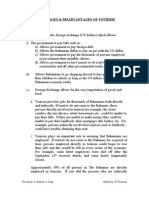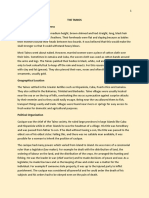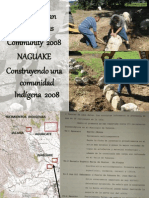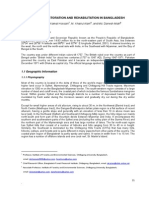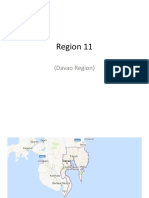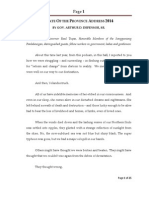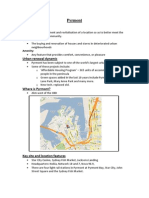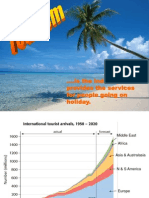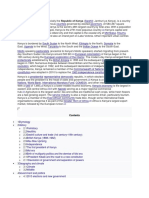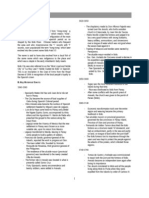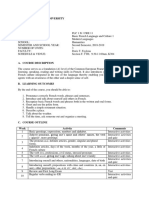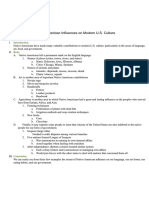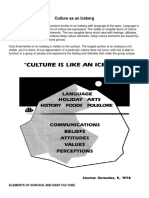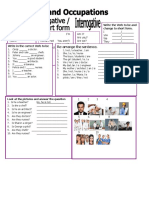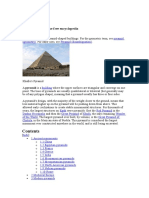Puerto Rico
Puerto Rico
Uploaded by
api-340505288Copyright:
Available Formats
Puerto Rico
Puerto Rico
Uploaded by
api-340505288Original Title
Copyright
Available Formats
Share this document
Did you find this document useful?
Is this content inappropriate?
Copyright:
Available Formats
Puerto Rico
Puerto Rico
Uploaded by
api-340505288Copyright:
Available Formats
Puerto Rico
TERESA
TERESA LANDEROS
LANDEROS P.2
P.2
Introduction
County Name: Puerto Rico
Capital: San Juan
Major Languages: English and Spanish
Location (continent): North America
Population: 3.548 million
Life expectancy: 78.54
Average age: 39.5 years
Geography: Major Landforms
Origin - Puerto Rico consist of fragments of continent carried on a
basement of Pacific Ocean crust.
Mountains - Mountains make up most of Puerto Rico's terrain, and the
Central Mountains run almost the entire length of the island from east
to west.
Karst - Karst indicates limestone landscape melted into a terrain of
caves, sinkholes, towers and ridges, as well as uniquely Puerto Rican
magotes, or "haystack" hills. A karst plateau from 140-million-year-old
seabed covers one-third of the island at 100 to 700 feet elevations in
the northern mountains.
Coastal Plains - A ribbon of beach and sand dunes backs Puerto Rico's
698 miles of shoreline, and a narrow coastal plain rests between
beaches and mountains.
Major Architectural and
Geographical Landmarks
Castillo San Felipe del
Morro
Located in the capital
city, it is an excellent
first pick amongst the
islands principle
landmarks. This fort has
stood since 1540,
protecting citizens from
atop a craggy
promontory jutting out
from the northwest edge
of the city.
Iglesia Porta Coeli
In San German, the second
oldest city in Puerto Rico,
this historic place is found.
It is one of the cities chief
landmarks, as the oldest
church anywhere in the
Americas, built in 1606.
Masses are only held three
times per year, but the
church is open to visitors
continuously, with many
sacred objects and artifacts
lining its walls.
Tibes and Caguana
Puerto Rico's Taino hertiage is best
preserved in two different locations, Tibes
and Caguana. Tibes, located north of
Ponce, has many replicas of Taino
dwellings and is the location of historic
ceremonies. Caguana, an ancient
ceremonial site, is located just off
Highway 111, near Arecibo.
Major Bodies of Water
The island is located in the
Caribbean, between the
Caribbean Sea and the
North Atlantic Ocean.
Puerto Rico has lakes and
more than 50 rivers. Most of
these rivers are born in the
Cordillera Central, Puerto
Ricos principle mountain
range located across the
center of the island.
Major Cities of Puerto Rico
San Juan
Bayamn
Carolina
Climate
Puerto Rico is situated in the tropics and surrounded completely by
water, its classified as tropical marine. Characteristics of this type of
climate include small seasonal variations and a high relative humidity.
The prevailing winds, known as trade winds, blow from the east and
moderate temperatures so that the island rarely experiences extremes
of either heat or cold.
Average yearly rainfall: On the northern coast 1550 mm per year, while
the south coast has an annual average rainfall of 910 mm. The
mountains receive a lot more rainfall, between 3000 and 4000 mm
annually.
Average temperature: 26 degrees Celsius (79 degrees Fahrenheit)
Climate change will affect tourism, an important source of revenue for
islands. In Puerto Rico, 3.5 million tourists spent $3.5 billion in 2009
Culture
Government - Puerto Rico is a self-governing commonwealth in
association with the United States. The chief of state is the
President of the United States of America. The head of
government is an elected Governor. There are two legislative
chambers: the House of Representatives, 51 seats, and the
Senate, 27 seats.
Major religions - The Constitution guarantees freedom for all
faiths. The major religions are: Catholic (85%), Protestants (8%),
non religious (2.3%), and others (3%).
Culture continued
Clothing - Light and loose cotton clothing is the best bet year-round
for Puerto Rico's warm tropical climate. The guayabera is the most
well-known garment from Puerto Rico. A kind of tailored shirt for
men, it has patch pockets on the front and is usually worn over an
undershirt.
Folk music - During Puerto Rico's colonial years, a series of musical
traditions evolved based on the folk songs and romantic ballads of
18th- and 19th-century Spain. Puerto Rican folk music would
comprise the primarily Hispanic-derived jbaro music, the AfroPuerto Rican bomba, and the essentially "creole" plena.
Food - Although Puerto Rican cooking issomewhatsimilar to both
Spanish, Cuban and Mexican cuisine, it is a unique tasty blend of
Spanish, African, Tano, and American influences.
Interesting Facts
Transportation - You can get to Puerto Rico by air, or by sea.
Once you arrive on the Island you can rent a car or use their
public transportation system. Driving is on the right-hand side of
the road. All the same rules as any part of the United States,
except that the signs are in Spanish, the distance markers in
kilometers and the gas sold in liters.
Laws - You must be 18 years old to purchase liquor in stores or
buy drinks in hotels, bars, and restaurants.
Puerto Ricos Flag
The white star stands for the
Commonwealth of Puerto Rico while
the three sides of the equilateral
triangle together represent the three
branches of the Republican
government (executive, legislative
and judicial branches). The three red
stripes symbolize the blood that
feeds those parts of the government.
The two white stripes symbolizing
the rights of man and the freedom of
the individual.
You might also like
- Puerto Rico Infosheet - Page 1 of 2 (Color)Document1 pagePuerto Rico Infosheet - Page 1 of 2 (Color)W. MeyersNo ratings yet
- Ajuy Ecological ProfileDocument7 pagesAjuy Ecological ProfileLoidaNo ratings yet
- Conservation Status and Threats Facing Shimoni ForestDocument55 pagesConservation Status and Threats Facing Shimoni ForestGVI Kenya - Conservation and community developmentNo ratings yet
- Costa Rica's National Sustainable Tourism Plan 2010-2016 (Plan de Sostenibilidad de Costa Rica)Document4 pagesCosta Rica's National Sustainable Tourism Plan 2010-2016 (Plan de Sostenibilidad de Costa Rica)CNCR NEWS100% (1)
- Riverplace Vision by NBP CapitalDocument22 pagesRiverplace Vision by NBP CapitalAnonymous UCTUgs0hWINo ratings yet
- Histoire D Haiti Tome V Thomas MadiouDocument3 pagesHistoire D Haiti Tome V Thomas MadioujedossousNo ratings yet
- Travel GeographyDocument2 pagesTravel GeographymaggiemenaNo ratings yet
- Bahamas - China Tourism Marketing OutlookDocument28 pagesBahamas - China Tourism Marketing OutlookstreethustleNo ratings yet
- Tourism Preparedness ProgramDocument17 pagesTourism Preparedness ProgramstreethustleNo ratings yet
- Advantages Disadvantages of TourismDocument3 pagesAdvantages Disadvantages of TourismSovannsetha100% (1)
- Haiti'S Declaration of IndependenceDocument10 pagesHaiti'S Declaration of Independencepolo007mxNo ratings yet
- The Tainos - ArawaksDocument5 pagesThe Tainos - Arawakstonk staryNo ratings yet
- African CulturesDocument2 pagesAfrican Cultureschrissar17No ratings yet
- Batey Naguake DIC 2014Document59 pagesBatey Naguake DIC 2014Naguake BorikenNo ratings yet
- Sustainable Tourism in Small IslandsDocument12 pagesSustainable Tourism in Small IslandsPawan CoomarNo ratings yet
- Proposed Eco-Tourism Plan - Baguan - Oct2007Document57 pagesProposed Eco-Tourism Plan - Baguan - Oct2007Don BakerNo ratings yet
- THC4 MODULE 01 - PrelimDocument11 pagesTHC4 MODULE 01 - PrelimDaril Jay R Lumilan100% (1)
- Forest Restoration and Rehabilitation in BangladeshDocument45 pagesForest Restoration and Rehabilitation in Bangladeshreads1234No ratings yet
- North Caroni Plains Case StudyDocument13 pagesNorth Caroni Plains Case StudyThe Cropper Foundation100% (5)
- WetlandsDocument68 pagesWetlandsRaúl Primitivo OrtizNo ratings yet
- RegionsDocument80 pagesRegionsanon_780056496No ratings yet
- Kaddish IntroDocument4 pagesKaddish Introchrystek007No ratings yet
- Jewish Kaddish: Ezek. Xxxviii. 23Document1 pageJewish Kaddish: Ezek. Xxxviii. 23gjbrown888No ratings yet
- The Need For A National Building Code For Trinidad and Tobago by Myron W. Chin 20 11-12-01Document6 pagesThe Need For A National Building Code For Trinidad and Tobago by Myron W. Chin 20 11-12-01myronchinNo ratings yet
- Iloilo Gov Defensor Sopa 2014Document25 pagesIloilo Gov Defensor Sopa 2014Eli Benjamin Nava TaclinoNo ratings yet
- Soil Coasteal in KenyaDocument10 pagesSoil Coasteal in Kenyaleonelcotes100% (1)
- History and Cultre of South East Asia 1Document28 pagesHistory and Cultre of South East Asia 1Skylar Smith Andreianna AndersonNo ratings yet
- Form 1 Natural HeritageDocument197 pagesForm 1 Natural Heritagenickelcalcium.00No ratings yet
- Paper La PerlaDocument23 pagesPaper La Perlagal3fcNo ratings yet
- GPTDocument30 pagesGPTDanish KhanNo ratings yet
- Endemic Species Found in The Albay Biosphere ReserveDocument13 pagesEndemic Species Found in The Albay Biosphere ReserveClark100% (1)
- Region IV-A (CALABARZON) : Area and LocationDocument8 pagesRegion IV-A (CALABARZON) : Area and LocationAimee EstimadaNo ratings yet
- Region IV ViDocument43 pagesRegion IV ViPrincess Lienard BrosasNo ratings yet
- Culture and Sustainable Development Indigenous ContributionsDocument6 pagesCulture and Sustainable Development Indigenous ContributionsZuzu FinusNo ratings yet
- Manila Bay: A Look at Manila Bay's Pollution and The Clean Water Act of 2004Document8 pagesManila Bay: A Look at Manila Bay's Pollution and The Clean Water Act of 2004NikkaDoriaNo ratings yet
- The Importance of The Rivers and Its MainDocument7 pagesThe Importance of The Rivers and Its MainMichael WolfeNo ratings yet
- Economic Organization - Indigenous PeoplesDocument32 pagesEconomic Organization - Indigenous PeoplesAKAYLA WELLINGTON100% (1)
- Taytay - Best Practice1 PDFDocument14 pagesTaytay - Best Practice1 PDFAnonymous bosozmWuATNo ratings yet
- Early English JamaicaDocument19 pagesEarly English Jamaicajurbina1844No ratings yet
- Trinidad and TobagoDocument14 pagesTrinidad and TobagoRonaldo HahnNo ratings yet
- Urban Places - Pyrmont Case StudyDocument4 pagesUrban Places - Pyrmont Case StudyShane DalyNo ratings yet
- 2a. TourismDocument85 pages2a. Tourismb_osborneNo ratings yet
- Geography of The PhilippinesDocument30 pagesGeography of The PhilippinesJoryl Shane Matero Ramirez100% (1)
- MayanpowerpointDocument11 pagesMayanpowerpointapi-438880639No ratings yet
- Classification of StreamsDocument20 pagesClassification of StreamsJeremiah Algem MendezNo ratings yet
- History of City-Formation and Lessons For Heritage ConservationDocument44 pagesHistory of City-Formation and Lessons For Heritage ConservationAr Lorenzo EstoyeNo ratings yet
- W M / R I: Etlands Itigation Estoration SsuesDocument6 pagesW M / R I: Etlands Itigation Estoration SsuesnephembaniNo ratings yet
- Mining or Food? Case Study 2: Copper and Gold Mining Zamboanga Del Norte - Mindanao IslandDocument24 pagesMining or Food? Case Study 2: Copper and Gold Mining Zamboanga Del Norte - Mindanao IslandSteve B. Salonga100% (1)
- Land and Water ResourcesDocument5 pagesLand and Water ResourcesCHARLIE MAGNE PESTOLANTENo ratings yet
- Kenya (: ListenDocument12 pagesKenya (: ListenLaura Maria GalanNo ratings yet
- Iloilo City SEP 2011Document188 pagesIloilo City SEP 2011winmarcellaNo ratings yet
- Chapter One 1.1. Background of The Study: Iloilo City's Heritage Tourist Destinations Are Worth Keeping ForDocument2 pagesChapter One 1.1. Background of The Study: Iloilo City's Heritage Tourist Destinations Are Worth Keeping ForCrisNo ratings yet
- Yamaye - WikipediaDocument25 pagesYamaye - WikipediaAlex Moore-Minott100% (1)
- Southwest AsiaDocument36 pagesSouthwest AsiaRhe YaNo ratings yet
- Barbados - PPTX FinalDocument33 pagesBarbados - PPTX FinalAnnyNo ratings yet
- Endemic Species in BatanesDocument15 pagesEndemic Species in BatanesGeraldine BallesNo ratings yet
- Montabiong Open Dumpsite For The Municipality of Lagawe-PaperDocument4 pagesMontabiong Open Dumpsite For The Municipality of Lagawe-PaperRevelyn Basatan LibiadoNo ratings yet
- The Rich Port:: Puerto RicoDocument21 pagesThe Rich Port:: Puerto RicoRoneil Quban WalkerNo ratings yet
- SCRIPTDocument11 pagesSCRIPTAqsa Naseer AhmedNo ratings yet
- Stockholm City - Draft2aDocument14 pagesStockholm City - Draft2aapi-3744430No ratings yet
- 1st Year Urdu Ghazal 1 NotesDocument9 pages1st Year Urdu Ghazal 1 NotesDawood Rehman100% (3)
- Ethics of CorruptionDocument24 pagesEthics of CorruptionGururaj PaiNo ratings yet
- Consumer Behavior BuyingDocument5 pagesConsumer Behavior BuyingHetang Patel Mukhi50% (2)
- Ob2 Iimk 1Document76 pagesOb2 Iimk 1Ankita RoyNo ratings yet
- Catalogue 2007Document12 pagesCatalogue 2007Sneha RawalNo ratings yet
- Cultural GeographyDocument37 pagesCultural GeographyryuujinNo ratings yet
- French WorksheetDocument4 pagesFrench WorksheetRobert50% (2)
- Borrowed WordsDocument6 pagesBorrowed WordsDeepika SethNo ratings yet
- False Beginners StudentDocument195 pagesFalse Beginners StudentYa NaniNo ratings yet
- Tribals of Kerala ProfDocument3 pagesTribals of Kerala ProfVahid AreekkaraNo ratings yet
- The Hygge Conspiracy Charlotte Higgins Life and Style The GuardianDocument12 pagesThe Hygge Conspiracy Charlotte Higgins Life and Style The GuardianMatyas SzigetiNo ratings yet
- Statuta PPI Gent (Perhimpunan Pelajar Indonesia) Di Gent-BelgiaDocument5 pagesStatuta PPI Gent (Perhimpunan Pelajar Indonesia) Di Gent-BelgiaRomi NovriadiNo ratings yet
- Native American in Uences On Modern U.S. CultureDocument1 pageNative American in Uences On Modern U.S. Culturequdratullah ehsanNo ratings yet
- Swastik Cements Floriculture and Vertical FarmingDocument3 pagesSwastik Cements Floriculture and Vertical FarmingcvwNo ratings yet
- Shakespeare in BengalDocument11 pagesShakespeare in Bengalbirdguy.saikat9936No ratings yet
- Understanding Culture Society and PoliticsDocument4 pagesUnderstanding Culture Society and Politicsrex danielleNo ratings yet
- Surface Deep CultureDocument3 pagesSurface Deep Culturelikethemagician8564No ratings yet
- Talking About England PPT Flashcards Picture Description Exercises - 48992Document22 pagesTalking About England PPT Flashcards Picture Description Exercises - 48992Gheorghe DianaNo ratings yet
- Re-Arrange The Sentence.: Write The Verb To Be and Change To Short FormDocument1 pageRe-Arrange The Sentence.: Write The Verb To Be and Change To Short FormGise DalzottoNo ratings yet
- RSS Oru Vimarshana Vayana by KT HussainDocument240 pagesRSS Oru Vimarshana Vayana by KT HussainArshad PulikkalNo ratings yet
- Zahavi 1998 - The Fracture in Self AwarenessDocument15 pagesZahavi 1998 - The Fracture in Self AwarenessPhilip Reynor Jr.100% (1)
- PSL 2018 Special Issue 01-12 Dela Torre Et Al PDFDocument12 pagesPSL 2018 Special Issue 01-12 Dela Torre Et Al PDFFrances VilleNo ratings yet
- Our Distribution Channel PDFDocument7 pagesOur Distribution Channel PDFAli Muhammad SheikhNo ratings yet
- The Elves of Aerenal, Part One: DragonshardsDocument4 pagesThe Elves of Aerenal, Part One: DragonshardsSteampunkObrimosNo ratings yet
- الحضاره المصريه القديمهDocument61 pagesالحضاره المصريه القديمهLoly AliNo ratings yet
- Langholm Brochure PlanDocument4 pagesLangholm Brochure PlanindyanexpressNo ratings yet
- PulseDocument28 pagesPulseilookieNo ratings yet
- AP Dept Tests-Eo Test Held On 18-07-2011 - Results With Names-Kadapa DistrictDocument30 pagesAP Dept Tests-Eo Test Held On 18-07-2011 - Results With Names-Kadapa DistrictNarasimha SastryNo ratings yet
- Assignment: How Is "A Pair of Jeans" Different From "The Zoo"Document6 pagesAssignment: How Is "A Pair of Jeans" Different From "The Zoo"Al Haram60% (5)
